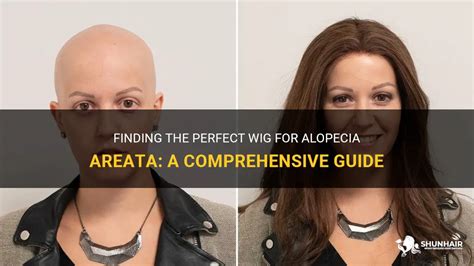Alopecia, a condition that causes hair loss, can affect anyone at any age. While there are no known cures for alopecia, wigs can provide a stylish and effective way to regain a sense of confidence and style.

Types of Wigs for Alopecia
-
Human Hair Wigs: Made from real human hair, these wigs offer the most natural look and feel. They can be styled and customized to suit your individual preferences. However, they are also the most expensive option.
-
Synthetic Hair Wigs: Made from artificial fibers, synthetic wigs are more affordable than human hair wigs. They come in a wide variety of styles and colors and can be heat-styled. However, they may be less comfortable to wear and can become frizzy or tangled over time.
-
Lace Front Wigs: These wigs feature a sheer lace front that creates the illusion of a natural hairline. They are more comfortable to wear and offer a more realistic look than other types of wigs.
-
Monofilament Wigs: These wigs are made with a thin, breathable fabric that allows your scalp to breathe. They are comfortable to wear and can be heat-styled.
-
360 Lace Wigs: These wigs have a lace cap that extends all the way around the head, providing a natural look from all angles. They are more expensive than other types of wigs but offer the most versatile styling options.
-
Clip-In Wigs: These wigs are attached to your own hair with clips. They are easy to apply and remove, making them a great option for occasional wear.
-
Halo Wigs: These wigs are made with a wire or elastic band that fits around the head, with hair extensions attached. They are lightweight and comfortable to wear, making them a good choice for everyday use.
Choosing the Right Wig
When choosing a wig, consider the following factors:
- Material: Human hair wigs are the most natural but also the most expensive. Synthetic wigs are more affordable but may not be as comfortable or realistic.
- Style: Choose a style that complements your face shape and personal style.
- Size: Make sure the wig fits snugly but not too tightly.
- Color: Choose a color that matches your natural hair color or highlights your features.
Benefits of Wigs for Alopecia
- Restore Confidence: Wigs can help you regain your self-esteem and confidence by providing a natural-looking head of hair.
- Protect Your Scalp: Wigs can protect your scalp from the sun and other environmental factors that can damage your hair.
- Freedom to Style: Wigs offer endless styling options, allowing you to experiment with different looks and colors.
- No Maintenance: Unlike your own hair, wigs do not require regular washing, drying, or styling.
Cost of Wigs for Alopecia
The cost of a wig for alopecia varies depending on the type of wig, material, and style. Human hair wigs can range from $500 to $3,000 or more. Synthetic wigs are typically less expensive, ranging from $100 to $500.
Where to Buy Wigs for Alopecia
Wigs for alopecia can be purchased from a variety of sources, including:
- Wig salons
- Beauty supply stores
- Online retailers
Tips for Wearing Wigs for Alopecia
- Apply a wig cap: This will help to protect your scalp and keep the wig in place.
- Secure the wig with wig tape or glue: This will prevent the wig from slipping or falling off.
- Style the wig: Use a wig brush or comb to style the wig as desired.
- Care for the wig: Wash and condition the wig regularly to keep it looking its best.
Conclusion
Wigs can be a valuable tool for people with alopecia who want to regain their confidence and style. By choosing the right wig and following the tips in this article, you can find a wig that meets your needs and helps you feel your best.
